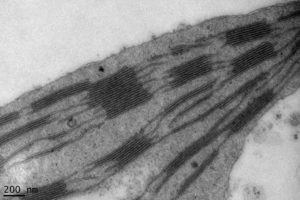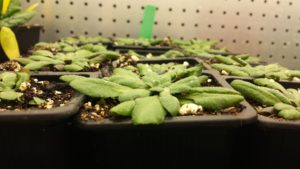Photosynthetic acclimation in the Arabidopsis thaliana thylakoid membrane
I graduated from the University of Sheffield in 2016 with an MBiolSci in Molecular Biology. During my undergraduate degree I carried out lab projects in X-ray crystallography, enzymology and molecular biology. My PhD project, also in Sheffield, focuses on the way in which plants adapt to their environment to maintain their photosynthetic efficiency.
Photosynthesis in plants takes place in an organelle known as the chloroplast. The process can be divided into the ‘light reactions’, which takes place in the thylakoid membrane, and the ‘dark reactions’, which take place in the stroma. The light reactions involve the absorption of light energy from the sun to power the splitting of a water molecule. The electrons and protons released from this process are used to generate a proton gradient, for ATP synthesis, and to produce NADPH. The ATP and NADPH are then used in the dark reactions to fix carbon dioxide from the atmosphere and synthesise biomolecules.
In the thylakoid membrane, light is absorbed by the light harvesting antenna complexes (LHC) and funnelled into the photosynthetic reaction centres of photosystem I (PSI) and photosystem II (PSII). Because plants are stationary, they need to adapt to different intensities of light arising from the weather and climate of their environment. Under low light, the rate of photosynthesis is limited by the amount of energy which is funnelled into the reaction centres. To compensate, the thylakoid membrane expands its light harvesting antenna to maximise the number of photons absorbed and increase the amount of energy reaching the reaction centres. Under high light, the rate of photosynthesis is limited by the rate of electron transfer through the membrane and by damage to the photosynthetic reaction centres. To compensate, the thylakoid membrane must increase its capacity for electron transfer, photoprotection and repair. The long term response to light intensity is known as ‘acclimation’.
The aim of this project is to analyse the changes which occur in the Arabidopsis thaliana thylakoid membrane during photosynthetic acclimation to determine how plants adapt to different intensities of light. A range of biochemical and imaging techniques, including mass spectrometry, pigment analysis, electron microscopy (EM) and structured illumination microscopy (SIM) will be used to provide a complete picture of thylakoid acclimation. This work will provide insights into a variety of mechanisms used by plants to maintain their photosynthetic efficiency and photoprotective capacity in different environments, with implications for improving crop yields for a growing world population and a changing climate.


Connect
Not yet available.

